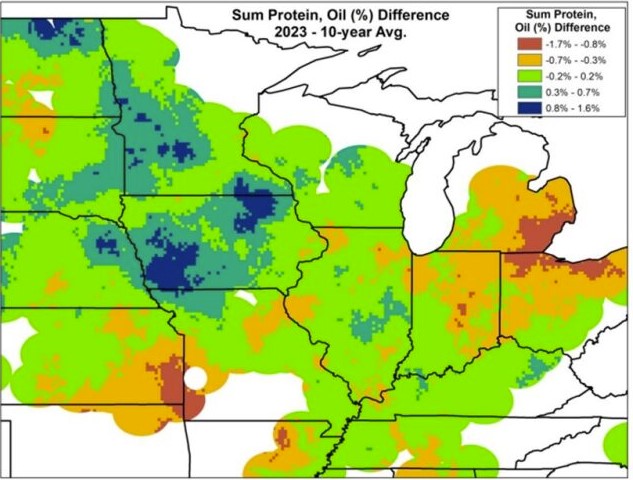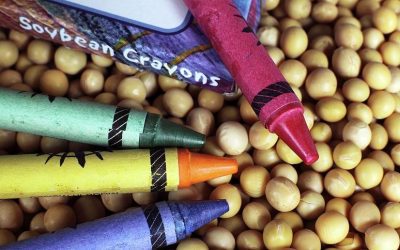By Colby Pinkstone, Senior Director of Strategic Programs
U.S. Soybean Export Council
Consistency and reliability matter to global U.S. Soy customers. As Indiana farmers prepare to plant their 2024 crop, it is useful to review the quality of the crop harvested in 2023 and being delivered to customers now.
Based on the 2023 U.S. Soy Crop Quality Report, U.S. Soy customers can expect increased protein and oil yields per ton, consistent soluble sugar and essential amino acids, and minimal total damage. Seth Naeve, professor of agronomy and plant genetics at the University of Minnesota, develops this report annually from hundreds of individual soybean samples and soy checkoff support. It dives into the details of the variations of the crop and how those variations affect soy quality.
Many factors, including weather, geography, growing and harvest conditions, impact soybean quality and composition, making characteristics vary from year to year. Nationally, 2023 produced a mixed bag for soybeans, due to persistent drought in some areas. Soybeans were drier than usual in many areas, leading to increased protein and oil yields per ton.
Despite challenges, farmers still produced a high quality, sustainable soybean crop, maintaining the value of U.S. Soy. The natural dry-down of U.S. soybeans also minimizes damage and increases sustainability.

Experts are describing 2023 as an “oil year” in soybean production. The national average oil content was 19.6 percent, .3 percent above the 10-year average. At the same time, protein content measured 33.7 percent, about .5 percent lower than the 10-year average.
Indiana experienced some of those drought conditions, but to a lesser extent than the other “I” states. As a result, the 5.83 million acres of soybeans harvested in Indiana in 2023 remained in better condition than the national average throughout the season. Most Indiana soybeans contained oil content higher than the 10-year national average, while protein was consistently below the 10-year average.
Translating quality to customer value
Why does soybean composition matter when farmers get paid by the bushel?
For customers, the value of soybeans comes from their components. Keeping their specific needs in mind and managing the crop to meet those needs increases their willingness to purchase U.S. Soy next season.

Soybean quality encompasses various factors, including suitability for various end uses, such as animal feed or oil extraction. The U.S. Soy Crop Quality Report 2023 explores factors like consistency of soluble sugar and essential amino acids, paired with minimal total damage to illustrate the superior quality and reliability of U.S. Soy production. For example, the soybean oil market focuses on free fatty acid content, while the feed industry needs energy and protein.
Soy food manufacturers consider seed color, damage and other physical characteristics.
“Current soybean quality assessments predominantly center around crude protein. However, a paradigm shift is imperative,” said Tom D’Alfonso Ph.D., director of animal and aquaculture for USSEC. “The evaluation scope needs to be broadened to encompass the complete nutrient bundle, integrating amino acids and digestibility, along with factors like sucrose and energy content. This holistic approach is essential for showcasing the true quality that translates into substantial feed cost savings.”
Implications for 2024
The report maps allow farmers to see the quality of soybeans from their area and consider how that applies to their end markets. For those raising high oleic soybeans, oil content and quality is key.
Likewise, those who know their soybeans primarily feed livestock focus on trends in protein and essential amino acid content. For those selling to the export market, both protein and oil matter.
The Crop Quality Report also builds understanding of how weather affects soybean composition. The regions of the U.S. with the biggest increase in protein plus oil content over the 10-year average also had the most drought.
Winter precipitation is replenishing soil moisture, but farmers should consider how conditions at planting and throughout the season could be impacting not just yield, but quality for their customers. Agronomic practices tied to soil health, like reduced- or no-till and cover crops, influence water holding capacity and nutrient availability, which influence soybean seed composition, size, weight and more.
The ability and willingness of U.S. Soy and Indiana farmers to use this type of information to adapt, innovate and improve soybean production even through adverse conditions demonstrates the industry’s reliability. And, it’s part of the reason customers around the world rely on them to supply high-quality soy that delivers nutrition, food security and sustainability for future generations.



